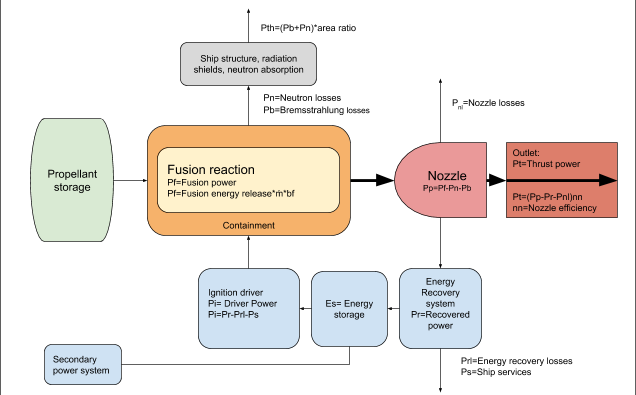Difference between revisions of "Nuclear fusion"
| Line 16: | Line 16: | ||
The power flow within a fusion propulsion system is shown in the following graph. The graph also shows the physical systems that are required to produce fusion propulsion system. | The power flow within a fusion propulsion system is shown in the following graph. The graph also shows the physical systems that are required to produce fusion propulsion system. | ||
| − | [[File:Fusiondrive.png|thumb| | + | [[File:Fusiondrive.png|thumb|800x800px|This diagram shows a flowchart for a fusion drive]] |
Revision as of 05:19, 4 September 2024
Modern nuclear power generates energy by splitting apart rare, huge atoms releasing the binding energy. This is called nuclear fission.
However, stars generate energy by joining small atoms into larger ones. This is called fusion. Fusion power plants have not been built on Earth yet. But if such a power source is created, it might be a good source of power on Mars.
Currently several countries and private firms are working to build a profitable fusion reactor.
Advantages on Mars
- Fusion may use Deuterium, an Isotope of hydrogen with one proton and one neutron. Deuterium is rare, and expensive to concentrate. However, Deuterium on Mars is 5 times more common than on Earth, so this concentration step would be 5 times cheaper. (In fact, deuterium is so expensive, it might be worth exporting concentrated deuterium to Earth.) If Fusion Propulsion space craft are built, Mars may be a spot to inexpensively refuel them. (Mars' low gravity makes getting fuel into space cheaper than on Earth.)
- Fusion powered ship should be faster than chemical ones, making the transit to Mars faster and easier.
This is a stub. Help Marspedia by expanding this article.
Fusion propulsion
General Physical Characteristics of Fusion Propulsion Systems
Fusion rockets use a propellant, which in most systems is comprised of the reaction products, unspent fuel, and other material directly involved in the underlying fusion reaction. These materials are contained within a reaction chamber and ejected via a magnetic nozzle. The nozzle typically includes an energy recovery system that is used to power the ignition system, called the ‘‘driver’’. A secondary energy production system is usually required to enable start-up of the propulsion system.
In some variations, the driver may be powered by an external source.
The power flow within a fusion propulsion system is shown in the following graph. The graph also shows the physical systems that are required to produce fusion propulsion system.







